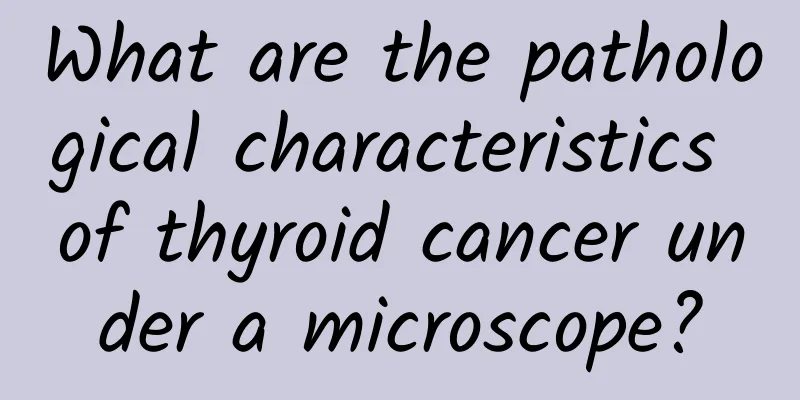What are the pathological characteristics of thyroid cancer under a microscope?

|
Author: Zhang Jinxia, Chief Physician, Peking University Shougang Hospital Reviewer: Wu Xueyan, Chief Physician, Peking Union Medical College Hospital The thyroid gland is a very important endocrine organ in the human body. It is shaped like a butterfly and is attached to both sides of the trachea. The right lobe is called the right lobe, and the left lobe is called the left lobe. Figure 1 Original copyright image, no permission to reprint As people's living standards improve and their health awareness increases, more and more people are undergoing regular physical examinations. Many friends will be diagnosed with thyroid nodules during thyroid screening. Thyroid nodule is a clinical diagnosis, which means that something grows on the thyroid gland. This thing can be round or irregular; it can be inflammatory or tumorous; it can be a cyst or a cystic-solid complex, and so on. For patients diagnosed with thyroid nodules, there is no need to be too nervous, because only 5% of thyroid nodules are thyroid cancer. Under the microscope, the thyroid gland is composed of thyroid follicular epithelial cells, neuroendocrine cells, and stroma such as lymph, blood vessels, and nerves. We usually say that thyroid cancer originates from the follicular epithelial cells and neuroendocrine cells of the thyroid gland. From a pathological perspective, thyroid cancer is divided into papillary thyroid cancer, follicular thyroid cancer, medullary thyroid cancer, and anaplastic thyroid cancer. Among these types, papillary thyroid cancer accounts for the highest proportion, about 70%-80%, follicular cancer accounts for about 10%, medullary cancer accounts for 5%-10%, and the rarest is anaplastic thyroid cancer. Anaplastic cancer has the highest malignancy and the worst prognosis, while papillary cancer and follicular cancer have the lowest malignancy and the best prognosis, and medullary cancer is in between. For different types of thyroid cancer, their characteristics under the microscope are different during pathological examination. Papillary thyroid cancer: Normal thyroid tissue is like beef, while papillary carcinoma is grayish white, hard, and feels gritty when cut, like cutting a pear. Under the microscope, we can see that papillary thyroid carcinoma forms many branched papillae, each of which has fibrous blood vessels in the center and is covered with follicular epithelium. The cells of papillary carcinoma are very distinctive. Under the microscope, the nucleus is transparent and appears frosted glass; there is overlap between the nuclei, and nuclear grooves can be seen; the cytoplasm is invaginated, forming red inclusion bodies in the nucleus; small, blue calcified bodies can be seen in the interstitium, so it feels like gravel when cut. Figure 2 Original copyright image, no permission to reprint Follicular Thyroid Cancer: Thyroid follicular carcinoma is often gray-red or gray-white, with a delicate texture like fish meat, with clear boundaries from the surrounding areas, and no gritty feeling when cut. Under the microscope, it is composed of a large number of well-differentiated follicles. This follicular structure is sometimes difficult to distinguish from normal follicles. We have to judge whether it is malignant by seeing whether it has invasion of the capsule and blood vessels. If it extends out and involves the capsule, or there is a tumor thrombus in the blood vessels, it is a very important feature of follicular carcinoma. Medullary Thyroid Cancer: The cancerous tissue of medullary thyroid carcinoma is also grayish white and hard to the naked eye. Under the microscope, the cancer cells are often groove-like, beam-like, and sometimes appear as small follicles. Its characteristic is the presence of red-stained amyloid deposits in the interstitium. In addition, patients may have elevated thyroid calcitonin and some clinical symptoms, which originate from neuroendocrine cells. Anaplastic thyroid cancer: Under the microscope, the cells are very abundant and the cell atypia is relatively large. They may appear as spindle-shaped sarcomas. In some places, giant cells can be seen, and residual remnants of thyroid follicular carcinoma or papillary carcinoma can be seen in the periphery. Anaplastic thyroid cancer is the most malignant of all thyroid cancer types and is very invasive. However, this type is relatively rare and can achieve a relatively good prognosis if discovered in time and treated actively. |
<<: Several major factors that affect glycosylated hemoglobin, are you affected?
>>: Thyroid puncture biopsy pathology report - interpretation of common terms!
Recommend
What is the cause of pelvic effusion during pregnancy?
A woman's body is more important after pregna...
What foods are good for hair loss during breastfeeding?
Women who are breastfeeding may also experience s...
Treatment of cystitis in women
We all know that women have a menstrual cycle eve...
There are more important things in a woman than beauty
1 Kindness For a woman, kindness is her bottom li...
How much weight is normal in late pregnancy
The fetus develops very quickly in the late pregn...
How to treat a hard cervix? Experts recommend these methods!
There are many diseases surrounding women's c...
Itchy blisters on vulva
Many women should have encountered this problem, ...
The Devil in the Head: Gliomas
The Devil in the Head: Gliomas Wang Mingyu The Fi...
Early symptoms of hyperthyroidism in women
Hyperthyroidism is a disease that causes great ha...
How many days of bleeding is normal after the IUD is removed?
The contraceptive ring is a commonly used method ...
How to prevent uterine prolapse
Uterine prolapse is a type of female gynecologica...
Can I take anti-inflammatory and anti-inflammatory medicine during menstruation?
Women’s bodies will be weaker during menstruation...
What should I do if I haven’t had my period for several months?
If a woman's body is relatively normal, there...
What to do if you have athlete's foot during pregnancy
In many of our minds, athlete's foot exists e...









